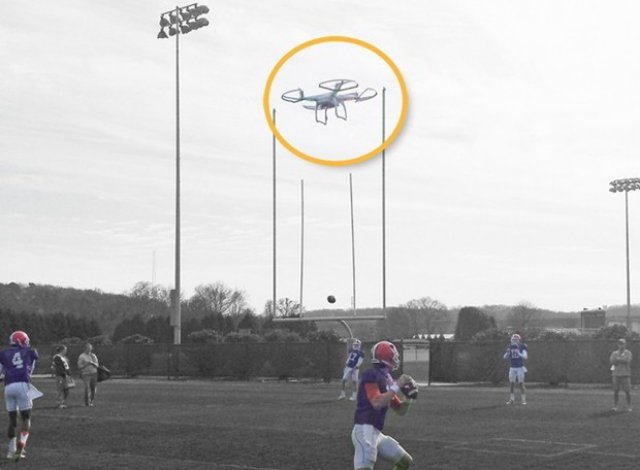Grady Jarrett, Clemson’s built-like-a-boulder nose tackle, thought he was hearing a swarm of bees last spring when he discovered the camera-equipped UAS hovering above the practice field. With the coaches’ children always buzzing around a Clemson practice, defensive end Vic Beasley said he first thought it was somebody’s toy. Instead, Clemson had joined the growing number of college football programs using UAS to record practices, and the results were met with wide acclaim.
“It’s awesome,” quarterback Cole Stoudt said. “It’s probably the one thing we watch the most.”
Images from the drone’s camera have provided another valuable tool for teaching, coach Dabo Swinney said.
“We didn’t know what the video was going to be like, but it’s incredible,” Swinney said. “In fact, we spend a lot of time watching that video as a staff.
“You can get right on top of things and see how they develop.”
Football teams have been recording practices from elevated vantages for a number of years, including cameras attached to long poles. TV networks use overhead cameras on wires during game telecasts.
The drone technology provided the next step, and the bird’s-eye view has been remarkable.
“From a quarterback teaching standpoint, it’s great,” Swinney said. Clemson uses the image as a simulator. “We can take a Nerf football into the meeting room, identify coverage and have them throw the ball at the screen.”
Considered more than model aircraft by the Federal Aviation Administration, which has led to an ambiguity in how drones are regulated, the smallest weigh about two pounds and sell for as little as $1,000.
About the size of a toaster oven, the craft is powered by rechargeable battery packs. Flight time runs to 25 minutes. Capable of hovering with four rotary copter blades, the results provide a valuable resource for football teams, especially the offense.
Rhett Brooks, a player development assistant for the defense, operates the drone. Hovering 10-15 feet above the field, the camera gives players and coaches a look at things videos have not.
Not only are the images helpful for the panoramas but in the detail difficult to detect from the tower or sidelines cameras – hand placement and footwork for linemen, blocking patterns and creases.
Receivers, like quarterbacks, can identify coverage and rotations.
“It’s fascinating how they use it,” said tight end Jordan Leggett, who admitted that initially he was skeptical. Once he watched, “It made a whole lot of sense.”
“It’s made us better players,” Stoudt said.
Game film was used extensively as an evaluation and teaching tool 70 years ago by Hall of Fame coach Paul Brown. Many coaches watched practice from towers for decades before the towers were retrofitted for cameras.
According to several published sources, a drone first appeared at a college practice when coach Butch Jones had one tested at Tennessee during 2013 spring practice. The next fall, drones hovered over practices at a few mores schools.
After UCLA coach Jim Mora mentioned the idea to reporters, a donor shipped him one, according to a story in the Wall Street Journal. And a class for entrepreneurs at Oregon State led to coach Mike Riley watching real-time images during a practice.
The FAA is expected to propose updated regulation for commercial drone use this year, according to the Wall Street Journal, and advocates predict more teams will embrace them for marketing and television production. More expensive models had been used extensively in filmmaking.
“Didn’t really know what we were getting into. Didn’t know if the images would be any good,” said Swinney, who joked that, initially, he feared it falling on him. “We had to learn how to fly it first.
“Now it’s just another tool in the box.”
Source: The State

